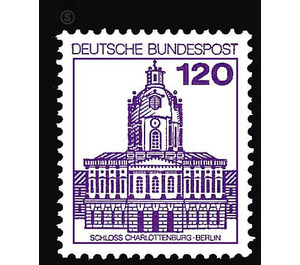Permanent series: castles and palaces - Germany / Federal Republic of Germany 1982 - 120 Pfennig
Theme: Architecture
| Country | Germany / Federal Republic of Germany |
| Issue Date | 1982 |
| Face Value | 120.00 |
| Color | violet |
| Perforation | K 14 |
| Printing Type | Lithography |
| Stamp Type | Postage stamp |
| Item Type | Stamp |
| Chronological Issue Number | 1014 |
| Chronological Chapter | GER-BRD |
| SID | 901158 |
| In 59 Wishlists | |
Supplementary values to the 1976/77 introduced roller-brand continuous series »castles and palaces«. The reel stamps appear simultaneously and identically with the inscription "Deutsche Bundespost Berlin". Charlottenburg Palace, closely linked to Prussian history, is an important Baroque building with an impressive domed tower and magnificent interiors. In 1695-99, Arnold Nering built the summer residence "Lietzenburg" for Elector Sophie Charlotte, since 1701 Prussian queen, named after the village of Lützow. Then perhaps Andreas Schlüter changed a lot, he possibly gave the halls a slimmer form, and in the following extended Eosander von Göthe the building to a representative residence. Leibniz saw "... a nice big model ..." and said: "... that will be very good ...". Influences from Versailles are clear. The construction was extended, a closed court of honor was built. Rich cultural life flourished, music and philosophy, such as B. Leibniz, moved in, festive events and theater plays took place. Leibniz counted the years of friendship with the queen as the happiest of his life. - After the death of Sophie Charlotte in 1705 King Frederick I had the castle expanded. Since then it has been called Charlottenburg. In 1712 the dome and the western orangery were completed. Frederick the Great lived here during the first two months of his reign and had Georg Wenzeslaus von Knobelsdorff build the new building from 1740 to 1746 instead of the planned eastern orangery. In 1742 Frederick the Great was received here by his friends, including Voltaire, on his return from the First Silesian War. Of course, since 1745 Friedrich has been in Potsdam and Sanssouci. In 1760 the Austrians and Russians devastated the castle. Friedrich Wilhelm II had 1788-90 by Karl Gotthard Langhans add the theater. Charlottenburg was then a favorite seat of Frederick William III. Napoleon lived here in 1806. Emperor Frederick III. resided in the castle from 1888 until shortly before his death. In 1943, it seriously damaged an air raid. After the Second World War, an exemplary restoration followed, a masterpiece of monument preservation. (Text: excerpts from the texts of the German Castle Association e.V. Braubach - Dr. W. Avenarius)


